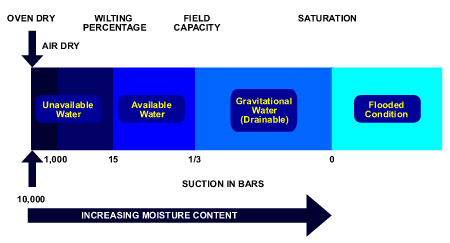Forms of soil water
![]() Understand soil-water relations such as mechanism of soil moisture retention, movement and availability.
Understand soil-water relations such as mechanism of soil moisture retention, movement and availability.
The capacity of a soil to retain moisture that is readily availale for plant growth is an important factor in irrigation and land use planning. This applies not only where there is adequate rainfall, but also in irrigation projects, where irrigation water has to be applied at the right time and at the right quantity.
Forms of soil water
- Gravitational or free water – This form of water is loosely held in the soil and could be easily lost by gravitational force.
- Capillary water – this form of soil water is held in the soil by capillary action (force) that is less than atmospheric pressure.
- Hygroscopic water – is a form of soil water that is present not only in the pores but also on the surface of the soil particle. It is tightly held in the soil and cannot be removed except by oven drying at 105 oC.
Graphical representations of the different forms of soil water are shown below.

These forms of water are important in understanding the soil water holding capacity.
We use "FOAM model" to fully understand the concept of soil water holding capacity. View the video below.
 |
Click on the play button to watch the video |
Next Lesson
Now that you can describe the forms of soil-water, we can proceed in discovering the water movement in soil-plant-atmosphere continuum.
1.0